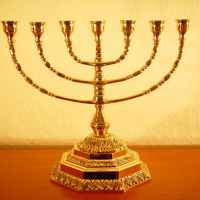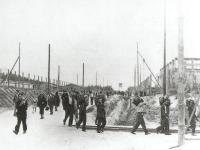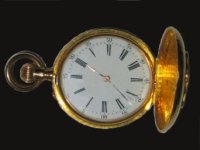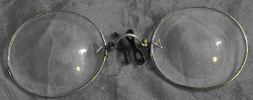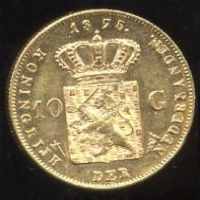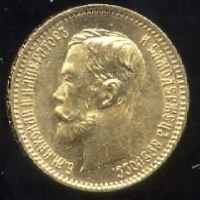On
5 January 1944,
Odilo Globocnik wrote to
Heinrich Himmler from
Trieste, setting out
details of the economic plunder of
Aktion Reinhard.
It followed an earlier report that
Globocnik had submitted on
4 November 1943.
In fine detail,
Globocnik calculated the gross yield to Germany of the murder
of some 2 million Jews at a sum in excess of 178 million
Reichsmark, then equal to US$71 million. The equivalent
value today (
2004) would be approximately US$760 million. Impressive though this
figure is, it represents no more than a fraction of the true extent of the larceny involved.
In the second of his letters,
Globocnik was at pains to stress the accuracy of his
bookkeeping, since "
a certain odium still rests upon me to the effect that in all
economic matters I do not
maintain the necessary order."
Globocnik was right to be concerned; after
all, he had been dismissed as
Gauleiter of
Wien in
January 1939 because of illegal currency dealings.
Doubtless, his reputation went before him, and he could hardly have been comforted by the web of corruption within
the SS revealed by the investigations of SS Judge
Konrad Morgen in
1943. Yet could
Himmler have really believed that
Globocnik’s financial statements were accurate? On
Globocnik’s own admission, "
What is remarkable about
the accounting is that no hard and fast basis for the amount collected existed, as the collection
of the assets was carried out under
orders and only the decency and honesty, as well as the surveillance, of the SS men used for this purpose could
guarantee a complete delivery." In other words, a financial free-for-all had prevailed. There was no real
supervision in place, no adequate system of checking and controlling the vast sums involved. But this was hardly
surprising. An ideology based upon theft and murder produces thieves and murderers, and whilst economic considerations
were never allowed to override the racial imperative, the two went hand-in-hand in the National Socialist state.
Theft, larceny and extortion could be characterised at two levels – the governmental, "legal" in the sense that
any act of government can be legalised, and personal, "legal" in that it was authorised (sometimes tacitly) by
government and "illegal", as practised by countless thousands of German civilians, members of the armed forces,
SS and police. And, as the opportunity arose, by many citizens of the countries occupied by, or allied to, Germany.
Although it can be said that
Aktion Reinhard entered its main extermination phase with the commencement
of killing operations at
Belzec in
March 1942, and concluded with
"
Aktion Erntefest" in
November 1943,
the periods preceding commencement and following conclusion are important for an understanding of the
economic development and importance of Nazi economic policy. In turn, it is necessary to examine the way in which
these policies were formulated, and for that a brief overview of the methods adopted in the
Reich and the
manner in which these were varied in the occupied territories is required.
The template for the economic exploitation and expropriation of Jewish property was laid down in the early
stages of the Third
Reich’s existence. "The Law for the Reestablishment of the Professional Civil Service" was
enacted by decree on
7 April 1933, little more than two months after the Nazi’s
seizure of power. At a stroke,
all "non-Aryan" members of the civil service were compelled to retire. It was the first in a series of such decrees.
Over the coming months and years, Jews were barred from practising law and medicine, dismissed from the
armed forces, prohibited from engaging in journalism and from the arts. No profession was left open to them.
Employers in every kind of undertaking were encouraged to dismiss their Jewish workforce. The conditions of
dismissal for employees became steadily worse, and the later a Jew was removed, the less his compensation
or pension. Ultimately, it became very difficult for Jews to remain in any kind of employment.
On
14 June 1938, the Ministry of the Interior published a decree defining a
"Jewish enterprise". This was the initial
move in the compulsory transfer of Jewish businesses into German hands. Previously, a Jewish business
could be either liquidated, and disappear, or be "Aryanized", and purchased by Germans. "Aryanization"
was in turn either voluntary (until
November 1938), or thereafter, compulsory.
The term "voluntary" was a misnomer,
since there was no open market negotiation of a business’ value. Jewish enterprises were purchased at heavily
discounted prices, encouraged by a series of government measures calculated to drive values down. The
introduction of compulsory "Aryanization" was effected through "trustees", appointed by the Ministry of Economics.
In many cases, virtually no compensation was paid for the acquisition of Jewish assets. The city of
Fürth,
for example, obtained 100,000
Reichsmark of Jewish communal property for 100
Reichsmark. The process was
simple; the "trustee" paid as little as possible and sold on to a German buyer for as much as possible. The difference
went to the
Reich, at least in theory. In practice, German purchasers were reluctant to pay the real market
value of Jewish enterprises, and it became necessary for the government to introduce an "equalization" tax in order
to collect their share of the spoils. In general, the purchaser of a Jewish business rarely paid more than 75% of its
value and frequently paid less than 50%. The profit to the business sector from this state controlled theft can be
calculated in billions of
Reichsmark.
But the state had acquired little direct financial benefit from this policy. Its windfall was to come from a penal
system of taxation. This comprised two property taxes – the so-called "
Reich Flight Tax" and the so-called
"Atonement Payment". The "
Reich Flight Tax" had, in fact been in existence since
December 1931, more than one
year before
Hitler attained power, and was intended to extract a proportion of the
value of the assets of those emigrating from Germany. By combining their enthusiasm for the emigration of Jews with a
lowering of the tax threshold, during their brief tenure in office, the Nazis obtained in the region of 900 million
Reichsmark from Jewish emigrants.
The "Atonement Payment" arose in the wake of the assassination of
Ernst vom Rath
by
Herschel Grynszpan and the subsequent
Reichskristallnacht of
9 - 10 November 1938. The Jewish community were "fined" an amount which eventually
amounted to 1.126 billion
Reichsmark
by way of reparation, payable in four instalments. The combined proceeds of the two taxes, an amount in excess of 2
billion
Reichsmark, was an essential contribution towards an economy that was heading for meltdown because of
excessive spending on armaments. The "Atonement Payment" also set the precedent for future German methods of extortion
in the occupied countries.
By
1939, the remaining Jewish community of Germany, now half its former
size because of emigration,
was impoverished. Those Jews who were still in employment had their wages reduced and their taxes increased.
What could be purchased with the little that was left to them was severely restricted by the imposition of rationing,
as the Germany economy entered a war footing. Rations for Jews were fixed at a level lower than that of the
general population. Together with a host of other restrictions, even the hours during which Jews were allowed
to shop were limited.
The economic exploitation of the
Reich Jews had maintained at least a façade of legality. With the invasion
of Poland, that façade was stripped away. The Jewish community of Germany had significant amounts
of capital, but were relatively few in number. In Poland, that position was precisely reversed. But that did
not mean that the opportunity for theft was to be overlooked. It had taken six years to pauperise the Jews
of Germany. The same result was achieved with Poland's Jews in a matter of weeks. Robbery of Polish
Jews and looting of their property became the norm. In every town and village, Jews were forced to hand
over not merely gold, currency and other valuables, but virtually anything consumable, including furniture
and clothing. Even items such as birdcages, door handles and hot-water bottles were looted. Any excuse,
or none at all, became the pretext for extortion. In the
Warsaw Ghetto,
Adam Czerniakow wrote in his diary:
"
It is raining. Fortunately that does not involve charges on the community."
Czerniakow's irony is understandable; the Jews of
Warsaw had already been forced to pay for the erection of the wall that
imprisoned them. Often, hostages were taken to ensure payment of Nazi demands.
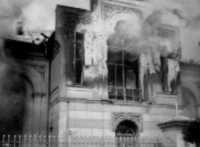 |
| Wloclawek Synagogue |
One example among many will suffice: on
Yom Kippur 1939, the Germans burnt down two
synagogues in the town of
Wloclawek. The fire spread to neighbouring houses.
The Nazis took 26 men into custody, forcing them
to sign a confession that they had started the fire. The men were then arrested, and told they would be
released on payment of a ransom of 250,000 Zloty. The Jewish population raised the money.
Shortly after, a new fine of 500,000 Zloty was imposed on the Jewish population for supposedly not
obeying the ban on their using the pavement.
Shortly after the entry of the German army into every town, soldiers and members of the civil
administration plundered Jewish homes. In many cases the local non-Jewish population helped the
Germans in searching for wealthy Jewish houses and shops. At the beginning of the Nazi occupation,
some confiscations of Jewish property were organised officially, but in many cases this looting was
undertaken on the private initiative of local Germans.
Ida Gliksztajn,
a survivor from the
Lublin Ghetto described her experiences:
"
On one occasion, two German soldiers and an official from the town hall arrived
to take pillow-cases
and sheets. It was at the beginning of the occupation and they gave us a receipt for about four
pieces of linen. Another time, several soldiers came to take the table, sofa bed and chandelier.
One Friday morning, two civilians and a man in uniform visited us. They were looking for
counterpanes but instead they took away a violin and a camera. On yet another occasion, the
Germans searched for gold. The search lasted the whole day. They ordered all of the women
in the house to undress themselves. We were not spared mockery and vulgar remarks."
Extortion on a grand scale took place throughout Poland. How much of these "fines" found their
way into the coffers of government is questionable. It was for good reason that
Hans Franks
Generalgouvernement (that part of Eastern Poland
not incorporated into the
Reich) was known as the "Gangster
Gau". A similar pattern was to emerge in
other territories occupied by the Nazis following the invasion of the former Soviet Union.
By
November 1939, all Jewish bank accounts in the
Generalgouvernement had
been blocked. Jews were only permitted to withdraw 250 zloty per week from these blocked accounts, or a larger
amount if needed for business purposes. At the same time, they had to deposit all cash reserves in
excess of 2,000 Zloty into the blocked account. On
24 January 1940, a decree
was issued requiring
the Jews of the
Generalgouvernement to register all property, including clothes, cooking utensils,
furniture and jewellery. Simultaneously, all Jewish property was subject to confiscation. Jewish
businesses were rapidly liquidated. In less than two years, 112,000 enterprises were reduced to 3,000.
The raw materials and finished goods of these liquidated firms provided a handsome windfall for the
Germans. The businesses themselves were sold to
Volksdeutsche for the price of the machinery
and inventory only. Poles ejected from the proposed ghetto areas were re-housed in the vacated
Jewish apartments, as were resettled
Volksdeutsche. The better Jewish homes were plundered
for furniture.
Even the creation of the ghettos themselves had a partial economic consideration behind it.
Ghettos were a much cheaper proposition than concentration camps. There was no need to
construct barracks, provide sanitation or light and heat. Guarding them was much simpler, and
cramming the Jews into a designated area facilitated robbery. In the
Warthegau,
Arthur Greiser said of the ghettos:
"
The Jews will remain there until what they have amassed to exchange for food is returned."
This was the essential economic thinking
behind the ghettos - press the Jews into a restricted area, steal from them what can be stolen,
forbid them to practise their professions or engage in gainful employment, maintain rations at starvation
level, and before they eventually die, they will be forced to exchange whatever remains of their wealth for
food. Which, to a great extent, is what happened. Typically, a ghetto resident would make up the deficit
in his or her weekly budget by selling some of their remaining personal possessions. There was
some trade between Jews, but in the main, a system of barter of goods for food with their fellow
non-Jewish citizens occurred. Since this was very much a buyer’s market, there was often no correlation
between the true value of these articles and the price the seller received. It has been estimated that
during the occupation, wages in the
Generalgouvernement rose 100%. In contrast, compared to
September 1939, the price of food in
Warsaw
markets had increased twenty-seven fold by
May 1942.
Incarceration in ghettos also opened up new possibilities for self-enrichment. The only legal source
of food was that purchased by the
Judenräte with funds collected from the ghetto population.
The food was supplied by the
Transferstelle,
Ghettoverwaltung (German administrative authorities)
or by municipal administration. The
Judenräte would pay for a specified quantity of food. Frequently,
a lower quantity was delivered. Moreover, if delivered, the food was usually of the lowest possible
quality, often inedible. Men like
Hans Biebow in
Lodz and many like him in
other ghettos accumulated great wealth from such transactions. In addition, only the smuggling of
food into the ghetto made existence possible at all. The opportunity for the bribery and corruption
of officials, from the heads of ghetto administrations to guards at ghetto gates, were endless, and fully
exploited by those in authority.
Initially, compulsory Jewish labour was only utilised for the most menial and strenuous work –
clearing rubble, draining swamps, building fortifications and the like. But in
mid-1940,
a shortage of skilled manpower forced the Germans to the realisation that the Jews could be put to more
productive use. In the wake of the occupying army, a host of would-be entrepreneurs had descended
on Poland. Men such as
Oskar Schindler and
Walter Toebbens arrived in much the same manner that carpetbaggers
had swooped on the Confederate States in the wake of the American Civil War. The pickings were rich.
When paid at all, salaries were miniscule. In
Warsaw, after deductions, an average
workshop employee
received 3 - 5 Zloty per day – not enough to buy half a loaf of bread. In many ghettos and factories,
even this tiny salary was not paid. The Jews became, quite literally, slave workers. They were "owned"
by the SS, who received an agreed daily rate from the industrialists for every labourer provided to them.
The workers’ reward was a midday plate of thin soup and a slice of bread. Given an insatiable demand
by the
Wehrmacht and others, together with minimum costs, even employers such as
Oskar Schindler, whose pre- and post-war activities hardly
suggest an acute business brain, could hardly fail to turn a profit.
Many German industrialists and merchants created large enterprises utilising Jewish labour. Some
German companies even controlled monopolies in the
Generalgouvernement for certain products,
and most of their workers were Jewish. A good example of this was
Viktor Kremin's
company, which confiscated all Jewish enterprises in the districts of
Radom, Lublin
and Galicia concerned
with the gathering of glass, iron, paper and rags.
Kremin not only seized the
buildings and stores of these entities, but also availed himself of the former Jewish owners together with their
workers. Because the gathering of industrial waste was important for the war economy,
Kremin's workers were actually temporarily saved at the time of the first
wave of deportations to the death camps.
At the same time, the SS themselves entered the market as major exploiters of Jewish labour.
Oswald Pohl, a former naval paymaster, set up a chain of SS
enterprises in labour and concentration camps. The organisation he controlled eventually evolved
into the
Wirtschafts-Verwaltungshauptamt
(
WVHA). Initially consisting of two main companies,
German Earth and Stone Works (
Deutsche Erd- und Steinwerke / DEST) and German Equipment
Works (
Deutsche Ausrüstungswerke / DAW), the organisation expanded to encompass divisions
involved in agriculture, food production, textiles and leather and other activities. One of the most
important of these was the production of munitions. Whereas in
1940, the Jews had
been considered
incapable of productive labour, by
April 1944 more than 28,000 of them were employed in the
armaments industry alone – and this after the slaughter of
Aktion Reinhard had ceased. At its height,
the
WVHA had a work force of more than 500,000 concentration camp prisoners at its disposal, making
Pohl one of the most powerful men in the SS. It was
Pohl who masterminded the economic aspects of
Aktion Reinhard,
organizing the disposal of the personal possessions of the murdered Jews. For the utilization of
Jewish labour was only an intermediary step prior to their murder. In
Pohl's
words: "
Employable Jews who are migrating to the East will have to interrupt
their journey and work in war industry."
Indeed, the use of slave labour was itself part of the extermination process, for the SS were hardly
caring employers, and working and living conditions in the camps and in the industries they supplied,
were uniformly dreadful.
On
1 December 1942,
Himmler wrote to
Pohl, stating that he had looked at the machinery and equipment in the
Warsaw Ghetto following the deportation of most of that city's Jews to
Treblinka. According to
Himmler, this equipment represented a windfall worth "hundreds of millions",
even though the majority of the machinery was actually private property. Utilising this equipment,
together with that recovered from the
Bialystok Ghetto on
12 March 1943,
the SS formed a new
company,
Ostindustrie GmbH (Osti), operating within the framework of the
WVHA. At its peak,
Osti employed thousands of Jews in various enterprises in
Dorohucza,
Lublin,
Radom,
Lviv (Lwow) and
Trawniki. In the various work camps of the
Lublin district and in
Majdanek alone, there were about
50.000 Jewish prisoners who worked for the
Osti factories.
Globocnik,
who was the head of
Osti, even wanted to transfer Jews from the
Lodz Ghetto to the
Lublin
district and to
use them as workers for his company. Because of the refusal of
Biebow
to cooperate and the liquidation of the Jewish work camps in the
Lublin district,
this idea was never pursued. The
Osti enterprise was short-lived. On
3 November 1943,
most of its workforce was shot in the
Aktion Erntefest. It was a classic example of racial policy
taking precedence over economic necessity.
 |
| Dental Gold |
 |
| Chopin Street Depot |
The city of
Lublin was the nerve centre of
Aktion Reinhard. It was from here
that the operation was organised and administered, and to here that the vast bulk of the proceeds of mass murder
were sent.
Globocnik issued instructions for a central register of all property
confiscated in the camps to be set up.
Georg Wippern was placed in charge of valuables and
Hermann Höfle was made responsible
for the sorting of clothing. At camps established at the
Airfield Camp (
Flugplatz-Lager),
and
Lipowa Street (
Lipowa Straße),
at the depot on
Chopin Street and elsewhere in the city, as well at
Majdanek concentration camp in
the city's suburbs, thousands of Jews laboured in conditions of the utmost harshness and brutality to
sort, repair, disinfect and pack everything from underwear and bedding to watches and currency.
Nothing was to be omitted.
Women's hair, shaved at the entrance to the
gas chambers, was sent
to Germany to be woven into felt stockings for railroad workers, socks for submarine crews, and perhaps
insulation material for German submarines. Dental gold, extracted from the mouths of gassed Jews, was melted and
delivered to the German
Reichsbank.
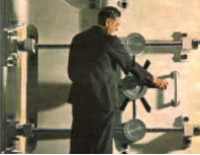 |
| Reichsbank |
In addition to the
Airfield Camp and
Chopin
Street,
there were two other localities in
Lublin where
Jewish prisoners sorted the property belonging to the victims of
Aktion Reinhard. One of these was the
SS-Standortverwaltung (SS Garrison Administration) on
Chmielna Street.
The main store for valuables and money plundered in the death camps and at
Majdanek
was located in the building of the former ocular hospital at this address. Small groups of Jewish workers, mainly
jewellers from the
Lublin Ghetto and bankers deported from
Terezin (
Theresienstadt), catalogued the
valuables and counted the money. Money and
valuables arrived at the
SS-Standortverwaltung without special documentation and it was only there
that lists of the gold and currency were prepared, prior to sending them to the
Reichsbank. It was
quite normal for the SS men who worked there to steal the best items for themselves. At the
beginning of 1943, when
Himmler visited
Lublin, a special exhibition
of jewellery was organised in the
SS-Standortverwaltung. According to the only survivor from the Jewish
commando that worked there,
Ignacy Wieniarz,
"
it was the best and biggest exhibition of Jewish jewellery in the whole of occupied
Europe at that time."
The other place connected with the plunder and sorting of Jewish property in
Lublin
was the work camp at the
Sports Field, (
Sportplatz),
and especially the former cosmetic factory owned before the war by the Jewish industrialist from
Lublin,
Roman Keindl.
The former owner worked there too, but as the
Lagerkapo. In his factory, which was under the supervision of
SS-Standortarzt (Garrison Doctor)
Sieckel, the cosmetics, medical equipment
and medicines which had been stolen from Jewish victims were separated and itemised.
Some idea of the thoroughness of this plunder of the murdered can be gleaned from an order issued by
August Frank of the
WVHA to the
Aktion Reinhard headquarters
on
26 September 1942. An edited version of these guidelines is worthy of reproduction:
1. All German currency will be deposited in the
WVHA account at the
Reichsbank.
2. Foreign currency, precious metals, diamonds, precious stones, pearls, gold teeth and pieces of
gold will be transferred to the
WVHA for deposit in the
Reichsbank.
3. Watches, fountain pens, lead pencils, shaving utensils, pen knives, scissors,
pocket flashlights and purses will be transferred to the workshops of the
WVHA for cleaning
and repair and from there will be transferred to SS troops for sale.
4. Men's clothing and underwear, including shoes, will be sorted and checked.
Whatever cannot be used by concentration camp prisoners and items of special value
will be kept for SS-troops; the rest will be transferred to
VoMi (
Volksdeutsche Mittelstelle /
Department for
Volksdeutsche, a section of the SS responsible for aiding Ethnic Germans in occupied countries).
5. Women's underwear and clothing will be sold to the
VoMi, except for pure silk underwear
(men's or women's), which will be sent directly to the Economic Ministry.
6. Feather-bedding, blankets, umbrellas, baby carriages, handbags, leather belts, baskets,
pipes, sunglasses, mirrors, briefcases and material will be transferred to
VoMi.
7. Bedding, like sheets and pillowcases, as well as towels and tablecloths will be sold to
VoMi.
8. All types of eyeglasses will be forwarded for the use of the Medical Authority. Glasses with
gold frames will be transferred without the lenses along with the precious metals.
9. All types of expensive furs will be transferred to the
WVHA. Furs of lesser quality will
be transferred to the
Waffen-SS clothing workshops in
Ravensbrück
near
Fürstenberg.
10. All articles mentioned in 4,5,6, of little or no value will be transferred to the
WVHA for the
use of the Economic Ministry. With regard to articles not specified above, the chief
of the
WVHA should be consulted as to the use to be made of them.
11. Check that all Jewish stars have been removed from all clothing before transfer.
Carefully check whether all hidden and sewn-in valuables have been removed from
all articles to be transferred.
The looting began in the camps themselves. Initially, the handful of deportees, selected from
arriving transports for work within the camps, were routinely murdered after a few days at most,
to be replaced by new arrivals. It quickly became apparent that this constant renewal of the
workforce caused disruption to and a slowing of the extermination process.
Franz Stangl, then commandant of
Sobibor, and ever the efficient
policeman, realised that a more permanent body of working prisoners was needed. To be sure,
murder of the workforce remained an ever present in all of the camps, and the ultimate fate of
the workers was never in doubt, but now it was at least possible to survive for more than a day
or two. Ironically, it is thanks to
Stangl that a handful of the working
prisoners were to live long enough to escape from
Sobibor and
Treblinka and provide us with eyewitness testimony of their horrors.
Amongst others,
Yankel Wiernik survived for a year in
Treblinka,
Richard Glazar
for ten months. In
Sobibor,
Toivi Blatt
endured captivity for six months. Of
Belzec, we have
the testimony of
Rudolf Reder, one of only two survivors of that camp,
and the sole provider of written survivor evidence,
Reder, who
was in
Belzec for approximately 4 months.
The first camp in which these changes regarding the workforce occurred, was
Sobibor, in
May or June 1942, to be followed
shortly thereafter by
Belzec and finally by
Treblinka in
September 1942 on
Stangl's appointment as commandant.
The prisoners were organised into small work groups with specific responsibilities. The
Goldjuden
("Goldjews"), about 20 in number and mainly comprising jewellers, watchmakers and bank
clerks, were responsible for receiving and sorting money, gold, foreign currency and other
valuables. The
Friseure (Hair Cutters) between 10 and 20 mainly former barbers, cut the hair
of the women at the entrance to the gas chambers. The largest group, numbering 80-120,
was the
Lumpenkommando (Sorting Team for Clothing and Belongings). Their job was to
collect and sort the victims' clothing and belongings and load them onto freight cars.
The clothing was carefully examined for hidden documents and valuables, and all markings,
such as the yellow star, which might identify the now deceased owner as a Jew, removed. There
were several other groups concerned with the collection and sorting of goods, as well as the
cleaning of the gas chambers, the disposal of bodies and other activities not directly connected to
the gathering of plunder.
The value of that plunder was immense.
Stangl himself described
how, on arrival at
Treblinka, where under
Irmfried
Eberl's command the camp regime had completely broken down:
"
I stepped knee-deep into money; I didn't know which
way to turn, where to go. I waded in notes, currency, precious stones, jewellery, clothes.
They were everywhere, strewn all over the square."
Samuel Willenberg, working in the sorting area at
Treblinka, opened sewn-up folds in clothing to remove gold coins,
roubles, dollars and diamonds.
Richard Glazar, another
prisoner at
Treblinka, tells of poles driven into the ground of the sorting yard
bearing signs reading "Cotton", "Silk", "Wool" and "Rags". Huge piles were stacked up beneath each sign.
Glazar commented:
"
It is all but impossible to imagine what can be found among the last things packed by
thousands and thousands. This is a huge junk store where everything can be found – except life."
Another
Treblinka inmate,
Alexander Kudlik, relates how he spent about six months going
through nothing but gold pens for ten hours a day. At
Belzec,
Rudolf Reder
described how a group of 8 dentists opened the mouths of corpses and extracted gold teeth. The
gold, money and valuables were sent to
Chopin Street in
Lublin. In
Sobibor,
Thomas Toivi Blatt, like prisoners in all of the camps, purloined money
and valuables to keep as a reserve in the event of escape and to barter for food with the Ukrainian guards.
The price of a sausage was a gold watch.
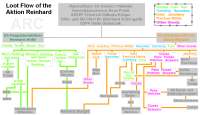 |
| Loot Flow Chart |
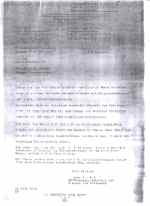 |
| Pohl Letter |
A precise system was drawn up in
Berlin for the disposal of the money and
valuables. Coins were retained by the Precious Metals Division of the
Reichsbank. Stocks, bonds and bankbooks
were sent to the Securities Division of the bank. Dental gold was sent to the Prussian State
Mint for melting. Jewellery was delivered to the
Berlin Pawnshop. The proceeds
of all of these activities were deposited at the Treasury, where they were credited to the Finance Ministry in
a special account in the fictitious name of "Max Heiliger". Withdrawals from this account were
included in the national budget.
The wealth of nations passed through these tiny camps in Eastern Poland.
Shmuel Rajzman testified how he and others kept count of the transports
leaving
Treblinka with the possessions of the victims. These included 248 railway
cars of clothing, 100 cars
of shoes, 22 cars of material, 260 cars of bedding, about 450 cars with various articles and household goods,
and hundreds more cars with rags; in total, about 1,500 cars full of the effects of murdered Jews.
Rajzman also told of how he had been informed by a Jew
responsible for packing valuables, that over 14,000 carats of diamonds alone had been sent from
Treblinka.
Abraham Lindwaser, also incarcerated in
Treblinka, reported that
during the period that transports arrived, an average of two suitcases, each containing 18 kg
of gold, were sent from the camp each week.
Treblinka provided the highest yield
of booty and the
most detailed witness testimony, but there is no doubt that the proceeds of annihilation were
proportionate to the number of victims. If the pillage was less at
Belzec and
Sobibor, this was solely due to the lower numbers murdered there.
 |
| Furs to Old Airfield |
All the trains with clothing were sent to the
Airfield Camp in
Lublin, where 500 - 700 Jewish
prisoners worked, the majority of them women. An initial sorting had taken place in the
camps. Now the clothes were disinfected and further sorted first into men's, women's and
children's items, then into outer and under clothing and footwear. Finally, the neatly packaged
effects were loaded onto trains once more and distributed in accordance with
Frank's instructions of
26 September 1942
(reproduced above).
Pohl issued a report on
6 February 1943,
detailing the textile materials forwarded from
Auschwitz and from
Aktion Reinhard. Since the report dealt with
goods transferred during
1942, it is apparent that the bulk of the items had come from the
Aktion Reinhard camps. The
Reich Economic Ministry had received 262,000 complete men's
and women's outfits, over 2.7 million kg of rags, 270,000 kg of bed feathers and 3,000 kg of
women's hair.
VoMi and other organizations were in receipt of a further 255 freight cars of clothing and
textiles.
Franz Suchomel, in charge of the
Goldjuden in
Treblinka, related how, during
Eberl's tenure of office as commandant of
Treblinka, a messenger had
arrived from the
Führer's Chancellery. The messenger carried instructions from
Werner Blankenburg of the euthanasia programme, to collect one
million
Reichsmark. A suitcase was duly filled and handed over. No questions were asked. The messenger
returned to
Berlin. It was only one of countless cases of pilfering by the SS at
every level, as well as
by their Ukrainian cohorts and anybody else unscrupulous and immoral enough to thrive on the misery of others.
Stangl believed that his immediate superior,
Christian Wirth, was bypassing
Aktion Reinhard headquarters
and transferring money and valuables direct from
Treblinka to
Berlin. Since, despite being nominally under
Globocnik's command,
Wirth
took instructions directly from
Viktor Brack in the
Führer's
Chancellery or from
Brack's deputy,
Blankenburg.
Stangl was probably correct in his suspicions. If so, it is likely that no
records of these particular transactions were kept.
When returning to Germany on leave, the SS would take suitcases and parcels full of Jewish belongings.
Abraham Krzepicki, a prisoner in
Treblinka,
reported how both, German and Ukrainian camp staff, had so much money he considered that they all
became millionaires. The Ukrainian guards stole money and valuables directly from the
Jews as they were brought to the camps. Sometimes they would burst into the barracks
where the
Goldjuden worked and steal whatever they could take. There was a thriving trade
between the Ukrainian guards and the local population. Money and valuables flooded into the
regions surrounding
Treblinka, Sobibor and Belzec, attracting speculators by the
score. Prostitutes arrived from
Warsaw and elsewhere to service the Ukrainians.
Jerzy Krolikowski, a Polish engineer who worked in the vicinity of
Treblinka wrote:
"
The poor areas of Podlassia
overflowed with gold, and riffraff from all over the country came there to get rich quickly and easily…
At first (the Ukrainians) were not aware of the real value of articles, and one could buy all kind
of things for next to nothing. Men's watches were sold literally for pennies, and local farmers
kept dozens of them in egg baskets to offer them for sale."
The greatest benefactors of this larceny,
of course, were the higher officers of the SS. Nobody will ever know how many millions were siphoned
off by them. Even
Hans Frank, Governor of the
Generalgouvernement,
was found guilty of purloining fur coats, gold bracelets, pens and rings as well as large quantities of food.
Hitler stripped
Frank
of all his Party offices. So much for
Globocnik's "decency and honesty".
The corruption and scandals concerning the SS men, connected with
Aktion Reinhard, were the reason for
the large-scale investigation organised within the SS by SS Judge
Konrad Morgen,
who arrived in
Lublin in
1943. The result of
this investigation was the arrest of several SS men from
Majdanek, including
the commandant of the camp,
Hermann Florstedt.
The prisoners, among them the Polish political prisoner
Jerzy Kwiatkowski,
had seen how
Florstedt and others often stole Jewish property:
"
SS men are looking for valuables. Apart from rummaging through the clothes and suitcases,
they unstitch the pillows, in which Schutzhaftlagerführer Thumann
finds diamonds and other precious stones. And Rapportführer Kostial
and other SS men are digging personally with spades in the Rosengarten
(Rose Garden), where the Jews spend the first night, or where during the day they wait in the queue for the
gas chambers or the bath. The SS are finding whole handfuls of rings, diamonds, gold, US Dollars and Russian
Roubles there."
The corruption affair at
Majdanek resulted in the death sentence for
Florstedt. In
1945, he was executed in
either the
Buchenwald or
Leitmeritz
concentration camp.
Morgen investigated 800 cases of corruption and murder, with
200 resulting in sentences. Amongst others executed was another sometime commandant of
Majdanek,
Karl Koch.
Hermann Hackmann, who had been in charge of protective custody at
Majdanek, was initially condemned to death, but instead was posted to a penal unit.
It should be stressed that
Morgen was in no way concerned with the acts of
murder and robbery carried out in the name of
Aktion Reinhard; these crimes were not only "legal", but also
essential. Rather, it was the "illegal" crimes, carried out for personal gratification or self-enrichment that
concerned him. Nothing better illustrates the absurd dichotomy inherent in Nazism than this spectacle of isolated
cases of murder being investigated in places where thousands were murdered daily. In any event,
Himmler became nervous about where
Morgen's
probing was leading. In
April 1944,
Morgen
was ordered to confine himself to the
Koch case. All other investigations
were stopped.
The end of
Aktion Reinhard did not signify the cessation of the murder and exploitation of the Jews.
Indeed,
Auschwitz-Birkenau was about to enter its most lethal and lucrative phase.
Jews continued to work as slave labourers in the
Lodz Ghetto until its
liquidation in
August 1944, and at many other labour
and concentration camps until the war's end. Under
Albert Speer,
who utilised millions of slave labourers for the purpose, armaments production soared to new
heights in
1944 - 45. But the killing and thievery never stopped.
The real economic value of
Aktion Reinhard is impossible to calculate. Large amounts of money
and valuables never found their way into the hands of the murderers. Tens of thousands of Jews
died en route to the camps, or were shot on arrival, and were buried in their clothes.
Abraham Krzepicki recounted how, on being instructed to
clear the
Schlauch at
Treblinka (the path leading to the gas chambers),
his group of workers
found "a veritable windfall of banknotes which people had torn up and thrown away before they
died." Papers which the Germans considered of no value, such as life insurance policies and share
certificates were burned in the
Lazarett, together with letters, photographs and other personal effects.
The worth of such items is unknown, and unknowable.
In the final analysis,
Globocnik's report was merely the tip of a
gigantic iceberg. How much of the plunder found its way into the vaults of Swiss Banks from
Nazi government and personal sources, can never be calculated.
Stangl
had no doubt that the economic implications of
Aktion Reinhard were of primary importance:
"
Have you any idea of the fantastic sums that were involved?" he asked
Gitta Sereny rhetorically. "
That's how the steel
in Sweden was bought."
Even the economies of neutral countries had benefited. The extent to which the looting fuelled the
post-war West German
Wirtschaftswunder (Economic Miracle) is a matter for speculation.
Certainly, major German banks and industries had profited handsomely from the annihilation
of the Jews. Poles, Ukrainians, Byelorussians and others moved into vacated Jewish premises.
They remain there in safety, for the Jews will never return. The value of property simply destroyed,
either by the Jews themselves in the face of death or by the Nazis and their collaborators, is incalculable.
Add to this the value of tens of thousands of slave labourers, working at little or no cost to their masters,
and the immensity of the larceny becomes apparent.
Yet there is another dimension to this tragedy. For how is it possible to quantify the value of
2 million lives cut short? Some victims were middle-aged, most in the prime of life.
Perhaps 500,000 of them were children. If a single life is priceless, how can a value be
placed on so many lives? For the Nazis not only stole the accumulated wealth of generations
and annihilated a society and a culture which had flourished for 500 years - they destroyed
that society's future capacity to earn, produce, create and expand. In laying waste to the past,
they also succeeded in obliterating the future. That is what was lost, and that is the true economic cost of
Aktion Reinhard.
Sources:
1) Hilberg, Raul.
The Destruction of the European Jews, Yale University Press, New Haven, 2003
2) Arad, Yitzhak.
Belzec, Sobibor, Treblinka - The Operation Reinhard Death Camps,
Indiana University Press, Bloomington and Indianapolis, 1987
3) Gutman, Israel, ed.
Encyclopedia of the Holocaust, Macmillan Publishing Company, New York, 1990
4) Padfield. Peter.
Himmler – Reichsführer-SS, Macmillan Publishers Limited, London, 1991
5) Höhne Heinz.
The Order Of The Death's Head, Pan Books Limited, London, 1972
6) Gutman Yisrael and Berenbaum Michael, eds.
Anatomy Of The Auschwitz Death Camp, Indiana
University Press, Bloomington and Indianapolis, 1994
7) Epstein Eric Joseph and Rosen.
Dictionary Of The Holocaust, Greenwood Press, Westport
Connecticut and London, 1997
8) Gutman Yisrael.
The Jews Of Warsaw 1939-1943, Indiana University Press, Bloomington and Indianapolis, 1989
9) Burleigh Michael.
The Third Reich – A New History, Pan Macmillan Limited, London 2001
10) Arad Yitzhak, Gutman Israel and Margaliot Abraham, eds.
Documents On The Holocaust,
University of Nebraska Press, Lincoln and London, 1999
11) Gilbert Martin.
The Holocaust – The Jewish Tragedy, William Collins Sons & Co. Limited, London, 1986
12) Donat Alexander, ed.
The Death Camp Treblinka, Holocaust Library, New York, 1979
13) Sereny Gitta.
Into That Darkness – From Mercy Killing To Mass Murder, Random House UK Limited, 1995
14) Reder Rudolf.
Belzec, Fundacja Judaica w Krakowie, Krakow,1999
15) Blatt Thomas Toivi.
From The Ashes Of Sobibor, Northwestern University Press, Evanston Illinois,1997
16) Glazar Richard.
Trap With A Green Fence, Northwestern University Press, Evanston Illinois, 1999
17) Willenberg Samuel.
Revolt In Treblinka, Zydowski Instytut Historyczny, Warsaw 1992
18) Goldhagen Daniel Jonah.
Hitler's Willing Executioners, Little, Brown and Company, London, 1996
19) Kwiatkowski Jerzy.
485 dni na Majdanku, Wydawnictwo Lubelskie, Lublin 1966.
20) Archive of the State Museum Majdanek in Lublin.
Jewish memoirs and testimonies.
21) Archive of the Jewish Historical Institute.
Collection of the testimonies by Holocaust survivors.








